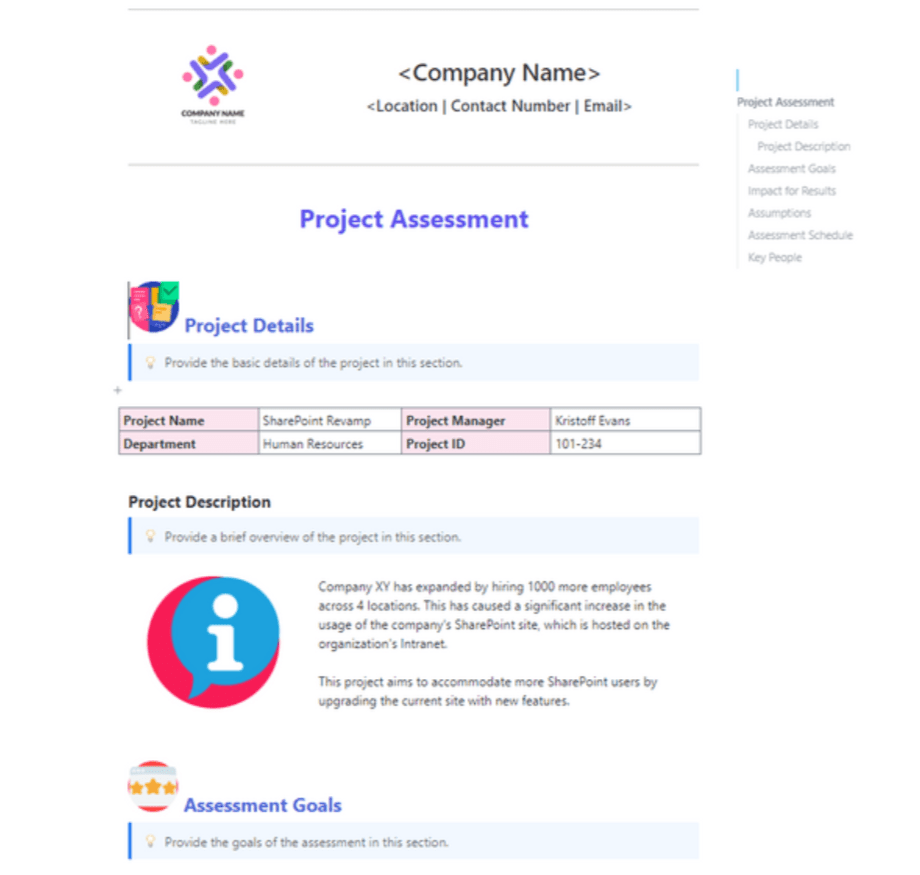بالنسبة لمديري المشاريع، يتضمن كل مشروع العديد من الأجزاء المتحركة والعديد من أصحاب المصلحة. إن مراقبة تقدم مشروعك وأدائه في الوقت الفعلي هو سر النجاح المستمر.
ومهما كانت الاستراتيجية جميلة، يجب أن تنظر من حين لآخر إلى النتائج
ونستون تشرشل
تقييم المشروع هو أفضل حليف لك في تقييم مدى فعالية مشروعك في تحقيق أهدافه وتقديم القيمة لأصحاب المصلحة. وسيساعدك الكشف عن رؤى التقييم هذه على اتخاذ قرارات ذكية تحسن نتائج أعمالك بشكل كبير.
في هذه المقالة، سنرشدك في هذه المقالة إلى الخطوات الحاسمة لإتقان عملية تقييم مشروعك. بالإضافة إلى ذلك، سننظر في مزايا ومخاطر تقييم المشروع ونستكشف أنواعه الأساسية. اربط حزام الأمان ولنبدأ!
ما هو تقييم المشروع؟
ببساطة، يتضمن تقييم المشروع تقييم نجاح المشروع. إنها عملية دقيقة تتضمن جمع بيانات المشروع التفصيلية واستخدام أساليب تقييم المشروع للكشف عن مجالات تحسين الأداء.
تقييم المشروع ليس مجرد مراجعة روتينية تُبقي أصحاب المصلحة على اطلاع على حالة المشروع. بل هو تحليل أكثر تفصيلاً يكشف عن فرص التحسين، فضلاً عن التعديلات المحتملة في الميزانية أو الجدول الزمني. ✅
يخضع كل جزء من المشروع، من النفقات والنطاق إلى المخاطر والعائد على الاستثمار، للتحليل لضمان التوافق مع الخطة الأولية. وتصبح أي عقبات أو انحرافات على طول الطريق رؤى قيّمة توجه التحسينات المستقبلية.
أدوات مثل
/href/ https://clickup.com/blog/project-dashboard/// لوحات معلومات المشروع /%/مرجع/
وأدوات التتبع حاسمة في تسهيل عملية تقييم المشروع. فهي تبسط الوصول إلى بيانات المشروع المهمة، مما يجعلها متاحة بسهولة ل اتخاذ قرارات مستنيرة والتعديلات الاستراتيجية.
ما هي الأنواع الرئيسية لتقييم المشاريع؟
في حين أن تقييم المشروع يمكن أن يحدث في أي وقت في دورة حياة المشروع، إلا أن هناك ثلاث نقاط محورية معينة حيث يكون التقييم التفصيلي للمشروع أمرًا ضروريًا.
تقييم ما قبل المشروع
يجب تقييم جدوى نجاح المشروع قبل البدء فيه. وعادة ما يتماشى هذا التقييم مع مرحلة التطوير الحالية للمشروع، وهو حجر الزاوية لتنفيذه بفعالية.
في هذا النوع من التقييم، يجب إنشاء فهم مشترك لما يلي الأهداف والغايات بين جميع أصحاب المصلحة قبل الموافقة على المشروع.
تقييم المشروع الجاري
خلال دورة حياة المشروع، من المهم التأكد من أن المهام المنجزة تتماشى مع المعايير المرجعية. يتضمن هذا النوع من تقييم المشروع البقاء في حدود الميزانية، والوفاء بمعدلات إنجاز المهام، و ضمان جودة العمل بشكل عام .
الحفاظ على تركيز الفريق على الأهداف الأولية يساعدهم على البقاء على المسار الصحيح مع تطور المشروع.
تقييم ما بعد المشروع
بعد اكتمال المشروع, تحليل الآثار والنتائج هي أولويتك الأولى. توفر النتائج معيارًا لقياس فعالية المشروع في تحقيق الأهداف والغايات المحددة مسبقًا حتى تتمكن من معرفة ما نجح وما لم ينجح.
كما يساعدك تقييم التأثير أيضًا على معالجة و حل المشكلات في المشاريع المستقبلية .
ما هي فوائد إجراء تقييم للمشروع؟
تمتد مزايا إجراء تقييم المشروع من نمو الفريق الداخلي إلى الانتصارات الخارجية. فيما يلي ملخص للفوائد الرئيسية:
- تتبع تقدم المشروع: يساعد علىتتبع أداء الفريق عبر المشاريع، مما يوفر سجلًا للتحسينات أو الانتكاسات بمرور الوقت
- تحديد مجالات التحسين: من خلال التعرف على الاتجاهات والأنماط، تحدد التقييمات مجالات التحسين داخل المشروع أو عمليات الفريق
- قياس الأثر: تقييم المشروع: تقييم المشروع يحدد أثر مشروعك، ويوفر مقاييس ملموسة وملاحظات لقياس نجاح مساعيك
- إشراك أصحاب المصلحة: إذا أشركت أصحاب المصلحة في عملية التقييم، ستطمئنهم على جودة المشروع,تعزيز الثقة والتعاون
- تشجيع المساءلة: يعزز تقييم المشروع المساءلة والتفكير بين أعضاء الفريق، مما يحفزهم على العمل الجاد من أجلالتحسين المستمر
- إثراء التخطيط المستقبلي: تؤثر الرؤى التي تجمعها من التقييماتخطط المشروع المستقبليةمما يسمح بإجراء تعديلات بناءً على أداء المشروع في الماضي والدروس المستفادة 👨🏫
- تشجيع المساءلة: يعزز تقييم المشروع المساءلة والتفكير بين أعضاء الفريق، مما يحفزهم على العمل الجاد من أجلالتحسين المستمر
كيفية إجراء تقييم للمشروع في 6 خطوات
إن فتح الطريق إلى تقييم مشروع ناجح لا يقتصر فقط على اتباع قائمة مرجعية -يتعلق الأمر بالاستفادة من الحق في أدوات إدارة المشاريع لتبسيط الرحلة
نحن هنا لتزويدك بالخطوات الست الأساسية التي يجب اتخاذها أثناء عملية تقييم المشروع وتزويدك بأفضل الأدوات التي ستساعدك على الارتقاء بمستوى التقييم. دعنا نستكشف! 🧐
الخطوة 1: تحديد أهداف المشروع وغاياته صياغة أهداف قوية والغايات أثناء تطوير مشروعك يشبه رسم خريطة لفريقك - فهي تحدد المسار والاتجاه.
تلعب الأهداف أيضًا دورًا حاسمًا في تشكيل عملية التقييم المصممة خصيصًا لأهدافك. على سبيل المثال، إذا كان هدفك هو تعزيز رضا العملاء، فقد يكون تقييمك التركيز على ملاحظات العملاء ومقاييس التجربة وجودة الخدمة.
لحسن الحظ، فإن الخطوة فائقة الأهمية المتمثلة في تحديد أهداف المشروع هي خطوة سهلة للغاية مع حل إدارة المشروع مثل انقر فوق . تعمل هذه الأداة الفعّالة على تبسيط مساعي مشروعك وبدء رحلة مشروعك من خلال مساعدتك على تحديد أهداف وغايات واضحة - كل ذلك في مكان واحد! 🌟
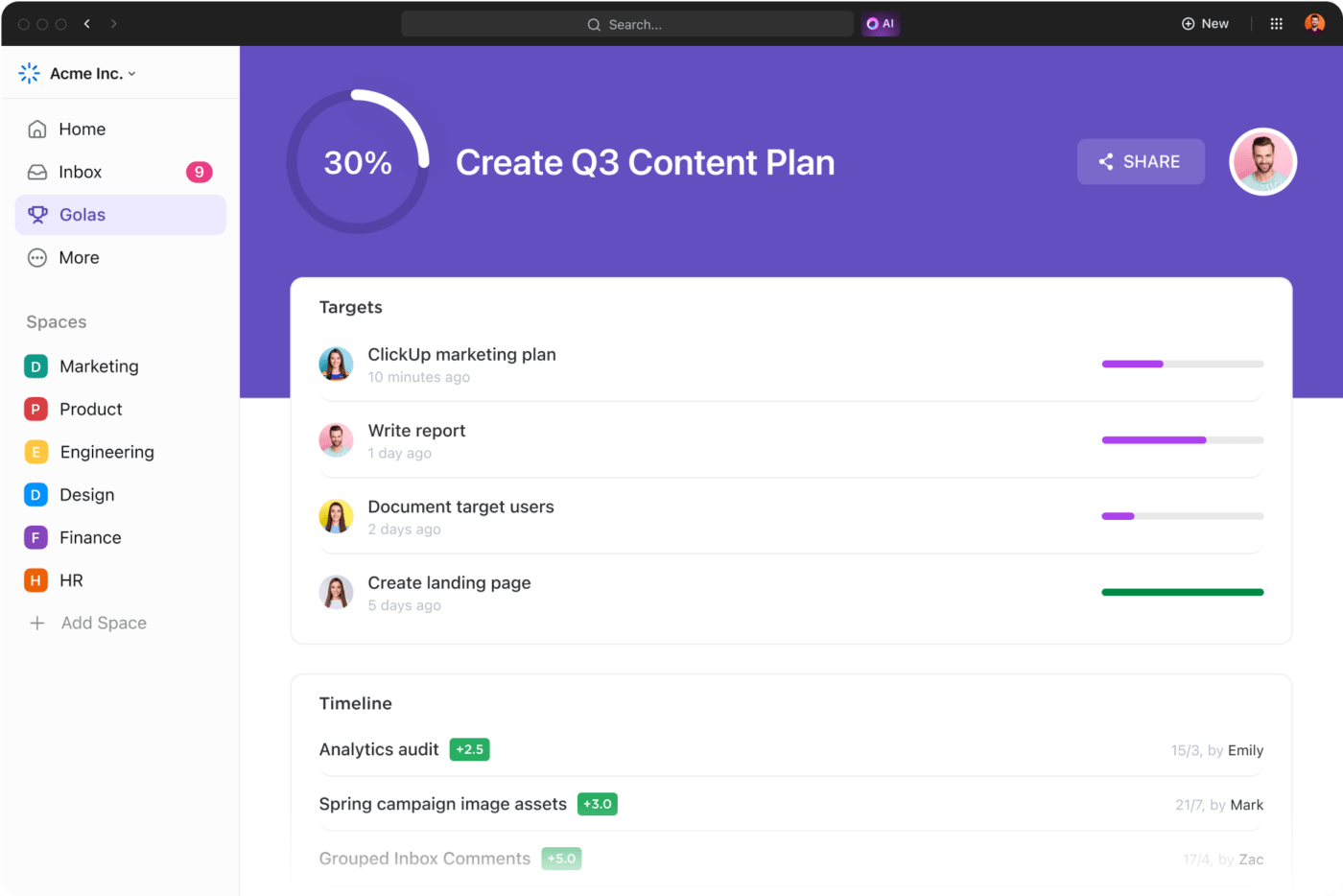
ضع أهدافًا قابلة للقياس للمهام والمشروعات مع التقدم التلقائي في ClickUp
مع أهداف النقر يصبح تحقيق أهدافك دون عناء. حدد جداول زمنية دقيقة وأهدافاً قابلة للقياس، ودع عملية التتبع التلقائي للتقدم المحرز تقوم بالمهمة الشاقة. ابدأ بإضافة التفاصيل الرئيسية - قم بتسمية هدفك، وحدد تاريخ الاستحقاق، وعيّن عضوًا في الفريق - وستكون جاهزًا للانطلاق!
يزودك ClickUp بما يلي:
- وضع أهداف رقمية للتتبع الدقيق
- وضع علامة على المعالم الرئيسية على أنها تم إنجازها أو معلقة لتتبع التقدم المحرز
- راقب الأهداف المالية لتحسين إدارة الميزانية
- ضع قائمة بالمهام الفردية كأهداف لمعالجة الأهداف المعقدة
قم بتسليط الضوء على اللحظات المحورية من خلال وضع علامة عليها كـ معالم بارزة وتحويل الأهداف الكبيرة إلى أجزاء يسهل على فريقك تحقيقها دون عناء.
والأهم من ذلك؟ يمكنك تجميع الأهداف ذات الصلة في مجلدات لتتبع التقدم المحرز عبر أهداف متعددة في لمحة سريعة مما يؤدي إلى اتخاذ قرارات أبسط. 🍒
الخطوة 2: تحديد نطاق التقييم
هل أنت مستعد للغوص في عملية التقييم؟ أولاً، دعنا نوضح أولاً سبب قيامك بالتقييم، وما الذي تهدف إليه، وما الذي تقيسه بالضبط. تذكر أن تحدد نطاق التقييم، بما في ذلك الأهداف، والإطار الزمني، وأصحاب المصلحة الرئيسيين، ومقاييس التقييم، والأساليب أو الأدوات التي تخطط لاستخدامها لجمع البيانات وتحليلها.
هذا الوضوح في الغرض والنطاق هو سلاحك السري - فهو يمهد الطريق لتقييم جيد التنظيم وفعال، مما يجعل تخطيط مشروعك وتنفيذه سهلاً للغاية. 🥧
لدى ClickUp الحل الأمثل لتوثيق نطاق عملك دون عناء. مع نموذج نطاق عمل ClickUp ، تحصل على إطار عمل جاهز لتوصيل جميع الأساسيات - يغطي كل شيء بدءًا من خلفية المشروع وأهدافه إلى الجداول الزمنية وتفاصيل الميزانية.
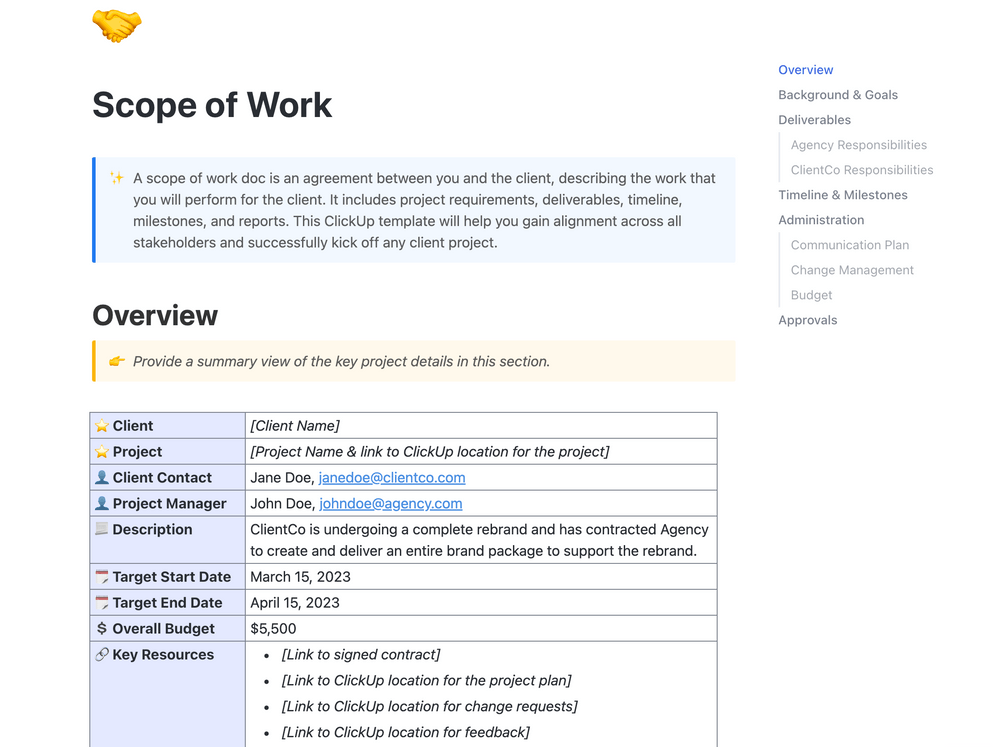
استخدم قالب نموذج نطاق العمل ClickUp لتحديد جميع تفاصيل المشروع لسهولة التقييم
قم بتخصيص جداولها المفيدة لتوثيق خصوصيات وعموميات عملية التقييم الخاصة بك. تخيل أن هدف التقييم الخاص بك هو تعزيز رضا العملاء. إليك لمحة سريعة عن كيفية توثيق النطاق:
- الأهداف: تعزيز رضا العملاء بنسبة 20% خلال الأشهر الستة القادمة
- الإطار الزمني: سيتم إجراء التقييم كل ثلاثة أشهر خلال العام المقبل
- أصحاب المصلحة: فريق خدمة العملاء، وقسم التسويق، وعملاء مختارين للحصول على تعليقاتهم
- المعايير: تشمل المقاييس صافي نقاط المروجين (NPS)، واستطلاعات آراء العملاء، ووقت حل استفسارات العملاء
- الطرق: استخدام الاستبيانات,نماذج الملاحظاتومجموعات التركيز، وتحليل قرارات الشكاوى لجمع البيانات والرؤى حول رضا العملاء
في مستندات ClickUp المرونة هي اسم اللعبة. يمكنك إضافة أو إزالة أقسام و الغوص في التعاون في الوقت الفعلي من خلال دعوة فريقك لتعديل المستند من خلال التعديلات والتعليقات. 💬
يأتي كل قسم محملاً مسبقاً بنماذج من المحتوى، لذا فإن تخصيص القالب الخاص بك سيكون سهلاً للغاية سواء كنت محترفاً متمرساً أو مبتدئاً في استخدام المستندات.
الخطوة 3: وضع خطة لجمع البيانات
الآن، حان الوقت للتشمير عن سواعدك وجمع البيانات التي تجيب على استفسارات التقييم الخاصة بك. كن مبدعًا - هناك الكثير من الطرق لجمع المعلومات:
- إنشاء استبيانات وتوزيعها
- جدولة المقابلات
- تنظيم ملاحظات مجموعة التركيز
- البحث في الوثائق والتقارير
التنوع هو المفتاح هنا، لذا استخدم البيانات الكمية والنوعية لالتقاط كل زاوية من زوايا مشروعك.
للحصول على رؤى لا تقدر بثمن حول مجالات التحسين ، نوصي بالتوجه مباشرة إلى المصدر - عملائك الأوفياء! 🛒
مع قالب نموذج ملاحظات ClickUp تحصل على نموذج قابل للتخصيص يركّز جميع ملاحظاتك. إنه جاهز لالتقاط التعليقات على كل شيء بدءًا من ميزات المنتج إلى دعم العملاء والتسعير.
يحتوي القالب على نموذج مخصص للتعليقات يمكنك توزيعه بسهولة على عملائك. وبمجرد ملء النماذج، انتقل إلى عرض قائمة تقييم الخدمة - وهو مركز التحكم الخاص بملاحظاتك الشخصية الذي يعرض الدرجات والأسباب الكامنة وراء التقييمات واقتراحات التحسين التي لا تقدر بثمن.
بالإضافة إلى ذلك، يمكنك التعمق في تقييمات مقدمي الخدمة في قائمة مخصصة واستكشاف لوحة التوصيات الإجمالية لتحديد المجالات التي تحتاج إلى تحسين في لمحة سريعة.
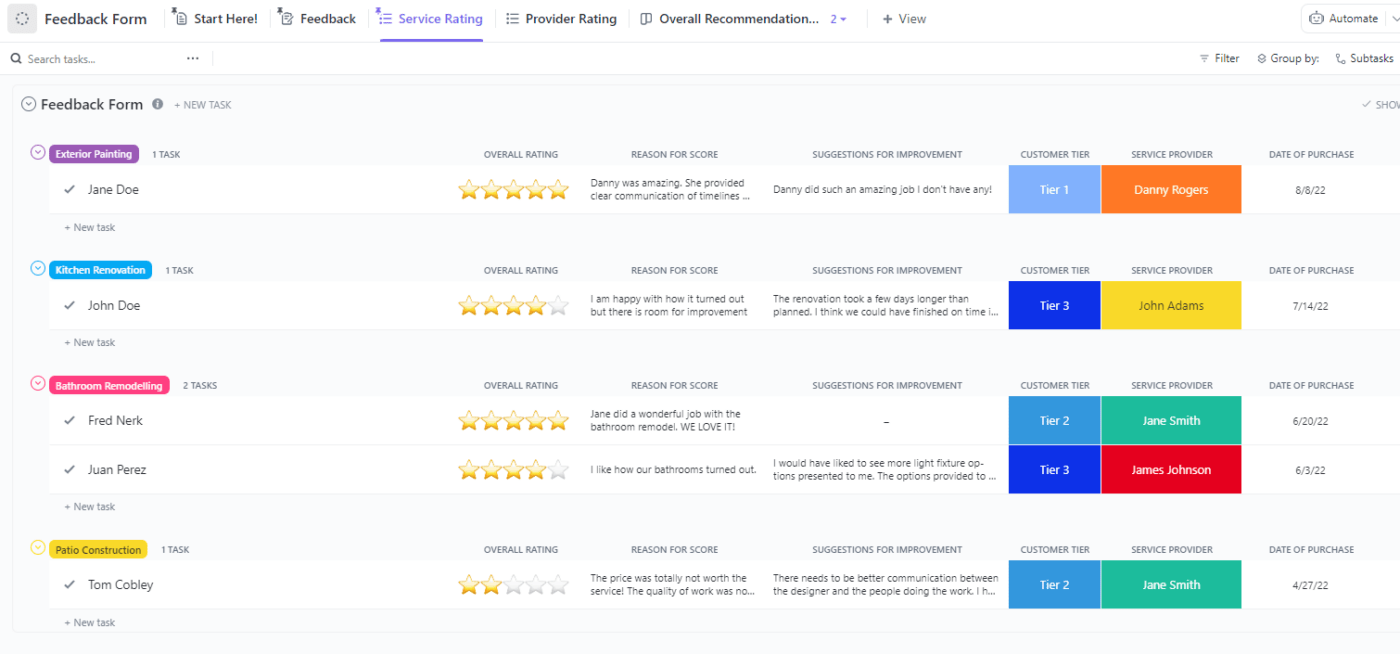
اجمع ملاحظات العملاء باستخدام قالب نموذج ملاحظات Clickup ونظمها في مكان واحد للحصول على رؤى أفضل
الخطوة 4: تحليل البيانات
بمجرد أن تصبح البيانات بين يديك، حان وقت التحليل! اختر الأدوات المناسبة من مجموعة أدواتك - الإحصاءات الوصفية، أو التحليل الموضوعي، أو تحليل SWOT -لإطلاق العنان للرؤى وفهم ما جمعته.
استفد من ClickUp Whiteboards إلى تنظيم تحليل SWOT ديناميكي مثالي للشركات التي تعمل عن بُعد أو الفرق المختلطة .
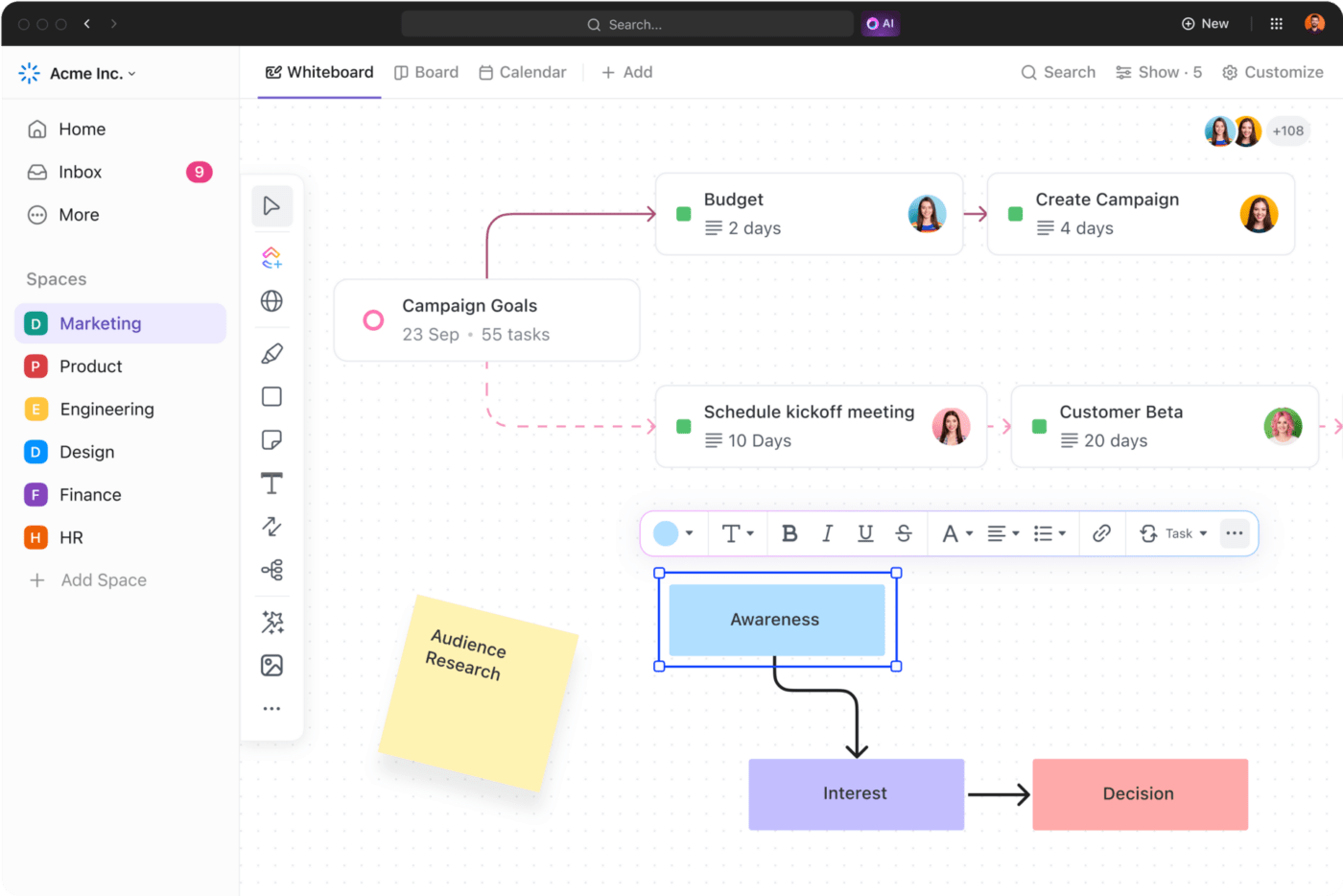
قم بالعصف الذهني أو وضع الاستراتيجيات أو تخطيط سير العمل بسهولة في ClickUp
ما عليك سوى إنشاء مربعات مرمزة بالألوان (أو أي شكل تريده) تمثل نقاط القوة ، نقاط الضعف ، الفرص ، الفرص ، التهديدات . بعد ذلك، قم بتنظيم بياناتك دون عناء من خلال إنشاء ملاحظات لاصقة وسحبها إلى المربع الصحيح، وها هي! السبورة البيضاء لتحليل SWOT القابلة للمشاركة جاهزة للعمل! 🎲
ألواح الكتابة الرقمية من ClickUp تشبه الألواح البيضاء المادية ولكن أفضل! يمكنك استخدامها من أجل:
- إجراءجلسات العصف الذهني التعاوني
- الاستفادةالخرائط الذهنية لتقسيم الأفكار الكبيرة إلى أجزاء صغيرة الحجم
- إنشاءأقسام مخصصة ل OKRsومؤشرات الأداء الرئيسية والبيانات الداخلية كمراجع سريعة
- مشاركة الأفكار مع فريقك من خلال الملاحظات اللاصقة والتعليقات والمستندات وملفات الوسائط
- حل المشاكل بطريقة إبداعية باستخدام الأشكال والمخططات والرسوم البيانية المرمزة بالألوان 📊 ClickUp Dashboards مثالية لتصور البيانات واتخاذ القرارات المستندة إلى البيانات. يمكنك الغوص في كنز دفين يضم أكثر من 50 بطاقة، وصياغة لوحة المعلومات المثالية التي تعكس رؤيتك. هل تريد رؤية تقدمك في مخطط بياني أو رسم بياني خطي أو رسم بياني شريطي؟ اختر ما تشاء واجعلها لك!
هذا العرض البانورامي ممتاز لرصد الأهداف، واستخراج الرؤى المهمة، وتعديل استراتيجياتك دون عناء. اعتمد على المخططات البيانية الدائرية والمخططات البيانية المتتابعة لتتبع الأداء مقابل الأهداف المحددة والتنبؤ بالطريق. 🛣️
سواء أكنت تشارك لوحة المعلومات داخل مساحة العمل الخاصة بك أو تعرضها بملء الشاشة في المكتب، فهي المحفز المثالي لمناقشات الفريق حول نقاط تقييم المشروع الرئيسية.
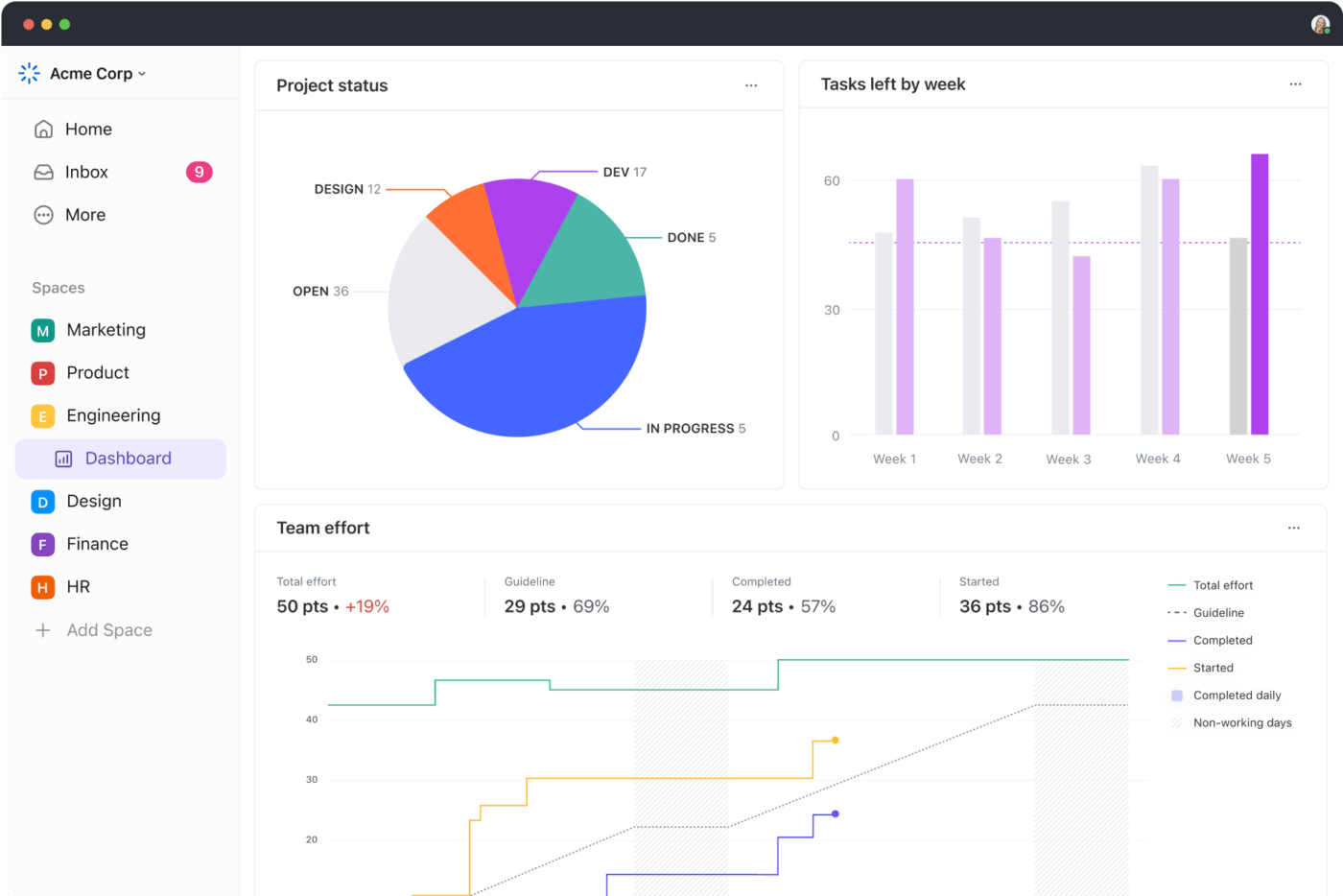
احصل على عرض شامل لحالات المشروع وحلل البيانات من خلال المخططات والرسوم البيانية في ClickUp
الخطوة 5: الإبلاغ عن نتائجك
بمجرد أن تتعمق في البيانات، حان الوقت لإبراز هذه الرؤى! إن صياغة تقرير هو خطوتك التالية - ملخص واضح وموجز يعرض النتائج والاستنتاجات والتوصيات الرئيسية لتقييمك. 📝
يتعلق إعداد التقارير بإيصال المعلومات الصحيحة إلى الأشخاص المناسبين، لذا قم بتخصيص تقرير تقييم مشروعك ليتناسب مع احتياجات جمهورك. سواء كان فريق مشروعك أو الجهات الراعية أو العملاء أو المستفيدين، قم بتخصيص تقريرك لتلبية توقعاتهم ومعالجة اهتماماتهم مباشرة.
تخلص من الحاجة لبدء تقريرك من المربع الأول باستخدام قالب تقرير تحليل بيانات ClickUp . توفر هذه الأداة القوية صفحات فرعية منفصلة لـ:
- نظرة عامة: الغوص في خلفية التحليل، بما في ذلك الأهداف والنطاق والمنهجية وطرق جمع البيانات
- النتائج: عرض نتائج دراستك واستخدام الرسوم البيانية والمخططات لتوضيح النتائج
- التوصيات والاستنتاجات: حدد استنتاجاتك وقدم خطوات قابلة للتنفيذ بعد التقييم
القالب قابل للتخصيص بالكامل، بحيث يمكنك تخصيصه ليناسب احتياجات عملك وتفضيلات جمهورك. قم بتعديل الجداول أو إنشاء جداول جديدة، وإضافة صفوف وأعمدة لعرض البيانات بشكل لا تشوبه شائبة. ✨
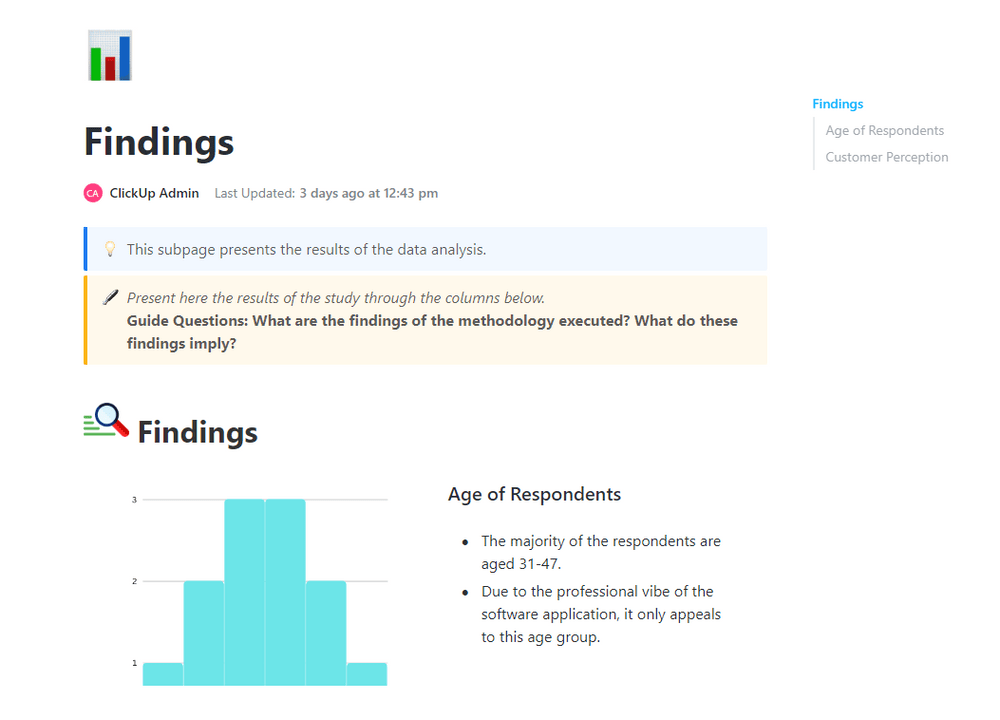
نظّم رؤى بياناتك وقدّمها بسرعة وسهولة باستخدام قالب تقرير تحليل البيانات ClickUp
الخطوة 6: مناقشة خطوات تقييم المشروع التالية
إن مشاركة نتائج التقييم ليست مجرد إجراء شكلي - بل هي محفز لعلاقات أقوى وأفكار أكثر إشراقًا. فهي تحفز المناقشات، وتدعو إلى تقديم اقتراحات مبتكرة لتحسينات الفريق، وتغذي روابط أقوى مع أصحاب المصلحة. بالإضافة إلى ذلك، إنها خارطة طريق للمشاريع المستقبلية توجيه الطريق إلى التحسينات بناءً على نتائج المشروع وتأثيره.
باستخدام ClickUp، يمكنك أن تقول وداعًا للتنقل بين لوحات معلومات إدارة المشروع ومنصات المراسلة. تعمّق في عرض الدردشة -بوابتك إلى المحادثات في الوقت الفعلي والمناقشات الخاصة بالمهام، كل ذلك في موضوع واحد مناسب. إنه مركز الاتصال النهائي، مما يبقي الجميع على اطلاع وتفاعل. 🕹️

إضافة أعضاء الفريق إلى المناقشات والتعاون مباشرة في ClickUp وتجنب التنقل بين البرامج
يعمل ClickUp Docs على تعزيز التعاون من خلال عمليات تحرير الفريق ووضع علامات على التعليقات وتخصيصات عناصر العمل - كل ذلك في مكان واحد. بالإضافة إلى ذلك، يمكنك تحويل النصوص إلى مهام قابلة للتنفيذ دون عناء، مما يضمن التنظيم والكفاءة في كل مرة.

تعاون مع أعضاء الفريق لتخصيص الخطوط أو إضافة علاقات المهام أو الارتباط بالمهام مباشرةً في المستند داخل ClickUp
علاوة على ذلك عمليات تكامل ClickUp تشمل العديد من أدوات المراسلة مثل Slack و Microsoft Teams، حتى تتمكن من التواصل بسهولة، سواء مباشرة في ClickUp أو من خلال منصات المراسلة المفضلة لديك! 💌
أخطاء تقييم المشاريع الشائعة التي يجب تجنبها
إن تحديد العقبات المحتملة في رحلة تقييم مشروعك هو خطوتك الأولى نحو اجتياز هذا المسار بنجاح أكبر. يمكن أن يكون الاعتماد على أدوات إدارة المشاريع في ClickUp والقوالب المعدة مسبقًا لتقييم المشروع بمثابة البوصلة التي توجهك لتجنب هذه الأخطاء. 🧭
إليك لمحة عن بعض الأخطاء السائدة في تقييم المشاريع التي يجب عليك تجنبها:
- أهداف وغايات غير محددة: إذا فشلت في وضع أهداف واضحة ومحددة وقابلة للقياس، فقد تعيق عملية التقييم لأنك لن تعرف أين تضع تركيزك
- التركيز غير المحدد: يمكن أن يؤدي تقييم جوانب غير ذات صلة أو إهمال عناصر حاسمة لنجاح المشروع إلى تقييمات غير مكتملة
- إهمال جمع البيانات وتحليلها: يمكن أن يؤدي جمع البيانات غير الكافي الذي يفتقر إلى المعلومات الحاسمة، إلى جانب التحليل السطحي، إلى رؤى غير مكتملة وفشل في تقييم أهم نقاط المشروع
- إساءة استخدام البيانات: إذا استخدمت بيانات غير صحيحة أو غير ذات صلة أو أساءت تفسير المعلومات التي تم جمعها، فمن المحتمل أن تتوصل إلى استنتاجات خاطئة، مما يؤدي إلى إبطال الغرض من تقييم المشروع بأكمله
- رد الفعل على الاستجابة: رد الفعل العاطفي بدلاً من الاستجابة بشكل منهجي لتحديات المشروع يمكن أن يحجب الحكم ويؤدي إلى تقييم غير فعال
- عدم التوثيق: يمكن أن يؤدي عدم توثيق عملية التقييم بدقة إلى عدم الاتساق ويؤدي إلى ضياع فرص التعلم
- محدودية مشاركة أصحاب المصلحة: عدم إشراك أصحاب المصلحة في وجهات النظر والرؤى المتنوعة يمكن أن يحد من عمق التقييم وأهميته
تبسيط تقييم المشروع باستخدام ClickUp
لضمان وصول تقييمك إلى الهدف المنشود، اعتمد على دليل تقييم المشروع المكون من ست خطوات والذي يضمن لك الغوص الشامل في جمع البيانات والتحليل الفعال وحل المشكلات بشكل تعاوني. وبمجرد مشاركة جميع النتائج مع أصحاب المصلحة، نضمن لك إعداد أفضل الحلول في أسرع وقت. اشترك في ClickUp مجانًا اليوم للحفاظ على مركزية تقييم مشروعك. هذه الأداة القوية ليست فقط حليفتك في تقييم المشروع - بل هي مساعدتك المطلقة طوال دورة حياة المشروع بأكملها! 💖
استفد من أدوات التعاون توفير الوقت مع أكثر من 1,000 قالب واستعد للإنتاجية التوربينية مع ClickUp AI تحقيق النجاح بشكل أسرع من أي وقت مضى! ⚡
